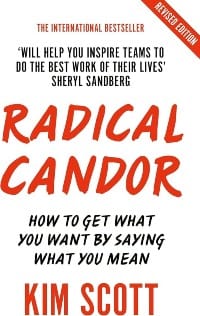Book Summary: Radical Candor
How to Get What You Want by Saying What You Mean

Receiving and giving feedback does not come naturally to me. Where I grew up and got my early exposure to the world, asking questions on how to do something better often meant questioning authority. Giving feedback was the anonymous complaint box and though later most companies I worked at adopted some form of performance management with 360 feedback, it didn't quite feel right.
Even during these years, I got exposed to good managers and started to see the gap between feedback for feedback's sake and feedback that prompts you to be better.
I am still not good at giving feedback. When I make the effort and gather my courage to give honest feedback, the words that leave my mouth are often not the ones I meant and for sure not the words that are needed to achieve any change in others' behavior. So when I got my eyes on a book which has the subtitle "How to get what you want by saying what you mean" I jumped on it.
The author, Kim Scott was a CEO coach at Dropbox, Qualtrics, Twitter, and before that worked as an executive at big tech companies like Google and Apple. Her book has two major themes in line with her experience:
- How to foster a culture of giving and receiving feedback in large organizations.
- How to do the same on an individual level.
I read the revised edition of Radical Candor which came not just updated parts of the book but with a new cover as well. Probably without the subtle change of the subtitle from "How to be a kick-ass boss without losing your humanity" to "How to get what you want by saying what you mean" I would not have picked this book.
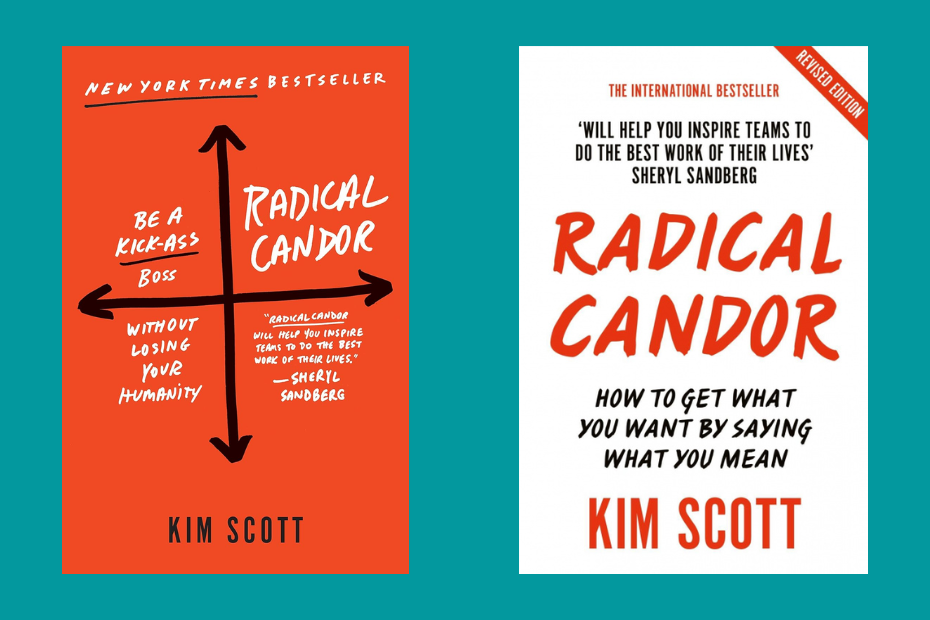
I did not care about the organizational implications and the meeting setup of big companies to foster Radical Candor, but the book came with both. However I needed to read all chapters because the everyday corporate moment's stories were the nuggets of wisdom that can be translated to use in everyday life as well.
There are those books that contain decades of work in a crystallized form. Radical Candor is one of them. There are so many unique concepts, practical advice, and exercises in this book that it makes it easy to sound smart when writing about it. I can feel good about myself by reading about giving feedback but without practicing it, this book and its summary is only procrastination.
The 4 Quadrants of Radical Candor
Radical Candor is about building strong connections with your peers while pushing to be effective in what you do. The concept draws four quadrants and puts management styles into these boxes according to how they are positioned in the "Care personally" and "Challenge directly" axis.
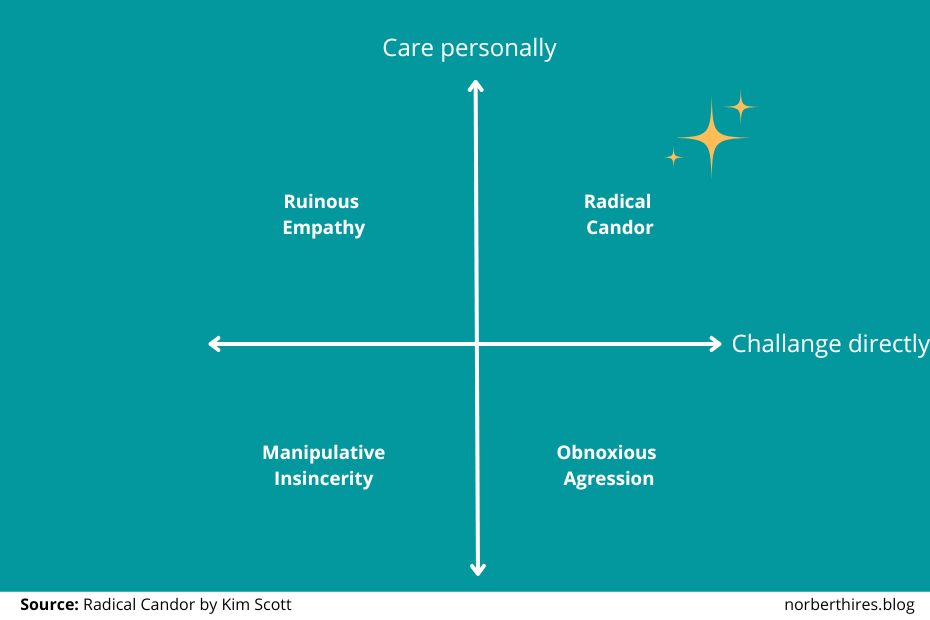
1. Obnoxious Aggression
The archetypical bad bosses have no problem giving negative feedback or calling out if someone's work falls below expectations (Challange directly). On the other hand, they do this in a way that disregards the receiver of the feedback and the situation (Care deeply).
Criticizing without showing care makes feedback feel harsh. While not ideal, it's better than being unclear—at least people know where they stand. This is why aggressive leaders often succeed, despite being unpleasant.
2. Manipulative Insincerity
Manipulative Insincerity in Radical Candor refers to a management style where a person neither cares personally nor challenges directly. This approach often involves passive-aggressiveness, backstabbing, or avoiding difficult conversations to maintain a false sense of harmony.
People in this quadrant may withhold honest feedback, gossip, or be politically motivated rather than genuinely helpful.
3. Ruinous Empathy
Several fresh managers who had an Obnoxiously Aggressive boss in the past feel their quest to make their direct report's life easier. They Care Deeply, but their empathy gets in the way of taking on unavoidable conflicts.
Their lack of will to challenge directly results in reduced effectiveness, and frustration, and in the end they have to make unavoidable decisions anyway like firing a low performer.
Being responsible sometimes means pissing people off. - Colin Powell
4. Radical Candor
Radical Candor represents the balance between Caring Personally and Challenging Directly. When you operate in Radical Candor, you provide honest, constructive feedback while genuinely caring about the person receiving it. This creates a culture of trust, where people feel both supported and pushed to improve.
For example: When a manager notices an employee struggling with presentations. Instead of bluntly saying, "Your presentations are boring," they say: "I see you put in a lot of effort, but your key points get lost. Let’s work together on making them clearer and more engaging."
Prompting and giving feedback
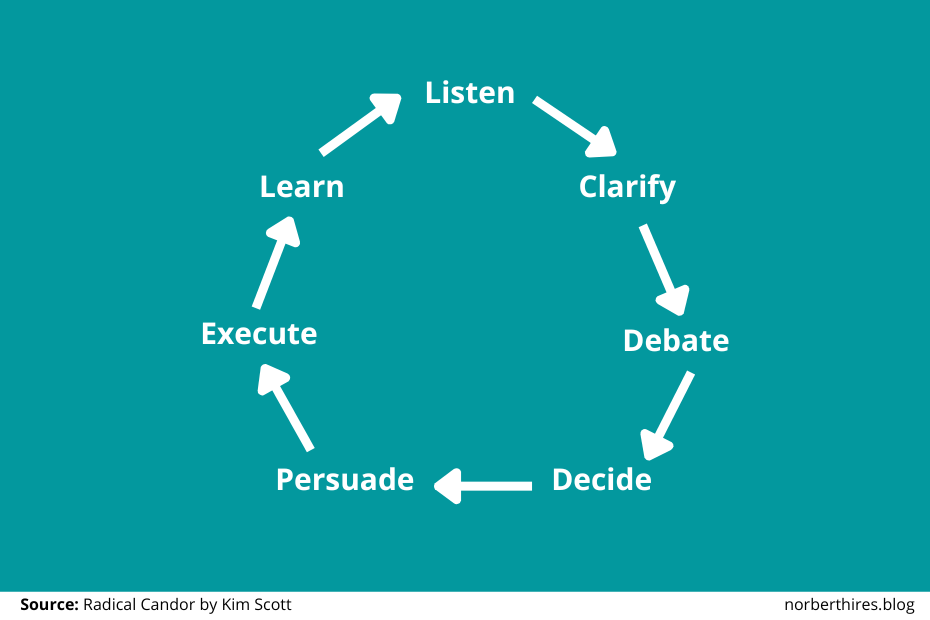
The most actionable part of Radical Candor was all the actionable advice on getting feedback and the explanation behind its importance.
The best bosses prioritize finding the right answer over simply being right. This mindset keeps them learning, improving, and encouraging their teams to do the same. Radically Candid guidance from a leader enables their team members to produce the best work of their careers.
Even in environments where an authoritarian approach is possible, the author has consistently found that collaboration leads to better results. Setting aside power fosters a more engaged and innovative team.
Apple's exceptional execution was driven by a relentless commitment to getting it right rather than being right. As Jony Ive, Apple's Chief Design Officer, once shared in an Apple University class, a manager’s most crucial role is to "give the quiet ones a voice."
On how to get feedback
- Feedback is a muscle: Giving and receiving feedback need to be practiced. We learn the rules of mathematics and then spend countless hours using them to solve problems. We should approach feedback the same way and make it a part of our everyday lives rather than an unpleasant part of occasional performance reviews.
- Start by asking, not giving it: The more feedback you receive the more you will feel how feedback lands and you will be able to give more candid feedback.
- Copy Toyota to prompt feedback: In Japan where the is a lot of emphasis on tradition and respect, it was culturally foreign to criticise management. To combat this taboo Toyota's leaders painted a big red square on the assembly line floor. New employees had to stand in it at the end of their first week, and they were not allowed to leave until they had criticized at least three things on the line.
- Questions to prompt feedback: To receive actionable feedback questions like "What could I do or stop doing that would make your lives better?" or "What could I do or stop doing that would make it easier to work with me?" can help. But in general, you should avoid using templates and sentences from a book and find your own questions which are appropriate for your situation.
- Avoid close-ended questions: Parents know that asking, "Did you have a good day?" often leads to a one-word response. Instead, a question like, "What were the best and worst parts of your day?" encourages a more detailed answer. The same principle applies when seeking feedback—open-ended questions lead to more meaningful insights.
- Share concrete feedback with a story: The more abstract feedback is, the more confusing it becomes. The more specific it is—especially when tied to a concrete example or story—the clearer and more impactful it will be.
Debate and convincing
Kim Scott shares an anecdote from her time in business school, where a professor recounted a meeting between President Franklin Delano Roosevelt and economist John Maynard Keynes. Despite spending over an hour together, FDR remained unconvinced by Keynes’s ideas—ideas that, if understood and applied, might have helped end the Great Depression sooner.
Scott’s professor then posed a thought-provoking question: Was it FDR’s fault for not understanding, or Keynes’s fault for not explaining it well?
This moment reshaped Scott’s perspective. She had always assumed that understanding was the listener’s responsibility, but now she saw that if an idea remains locked in the speaker’s mind, it may as well not exist.
It is the explainer’s duty to make their insights as clear to others as they are to themselves.
Best practices for productive debate
- Create an obligation to dissent: The author interned one summer at McKinsey and she was impressed by their ability to spark productive debate. If everyone was agreeing with a proposal, then somebody had to take up the dissenting voice during a debate.
- Switch sides: In debates, it's easy to become so emotionally attached to your position that it turns into a battle of egos rather than a pursuit of the best idea. To prevent this, try switching sides and arguing from the opposing perspective. This forces you to see the issue more objectively and strengthens your ability to engage in meaningful discussions.
- Know the person: Effectively presenting an argument in a debate requires not only a deep understanding of your position but also an awareness of your audience and how they perceive the issue.
- Pause when needed: There are moments when people are too exhausted, burned out, or emotionally overwhelmed to have a productive debate. Recognizing these situations is key, as they rarely lead to positive outcomes. In such cases, it's important to step in and call for a pause.
- Forget consistency: People often label changing one’s opinion as being inconsistent, unprincipled, or indecisive. However, the author aligns more with John Maynard Keynes’s perspective: "When the facts change, I change my mind."
On Relationships
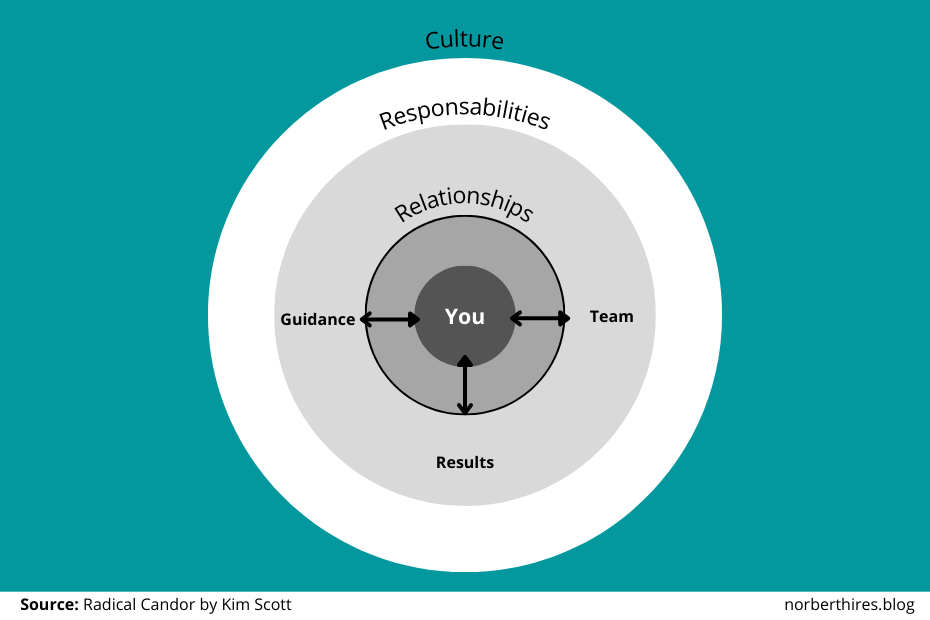
The chapter on relationships puts some of my lingering contrarian thoughts on paper better than I could ever do and even illustrates it in a cool way as above.
The author suggests pursuing work-life integration instead of work-life balance. Work-life integration is about bringing your best self to work—and taking that same energy back home. It is not viewing work-life balance as a trade-off where investing in one takes away from the other. Prioritizing things like sleep, which keeps you focused and effective, isn’t a personal indulgence at the expense of work or your team—it’s an investment in both.
Everything is centered around you. If you do not feel well, then you can not deliver results, it impacts negatively your relationship and you can not fulfill your responsibilities either.
The story of the executive who trained before and after work during stressful times especially resonated with me. I treat training as a non-negotiable part of my day as well. Through trial and error, I concluded that even getting late is worth it if I can sneak in training before work. I am more productive and more fun to be around. I am more centered.
The connection between responsibilities and relationships is also worth thinking about:
You can't fulfill your responsibilities without good relationships, but the way in which you fulfill your responsibilities is integral to those relationships.
Thoughts that caught my attention
- 10 silent minutes: Spending ten minutes in silence during meetings can help you hear what you might otherwise miss. When reacting too soon, people tend to say what they think the listener wants to hear. By staying neutral, they feel safer sharing honest thoughts.
- Hug for 6 seconds: Hugging for at least six seconds boosts oxytocin, often called the "bonding hormone," which helps reduce stress, increase trust, and strengthen relationships. It also lowers cortisol (the stress hormone), improves mood, and fosters a sense of connection.
- Walk instead of sitting: For difficult conversations, consider walking instead of sitting face-to-face. Walking helps keep emotions in check, reducing the chance of tension escalating. Plus, moving side by side fosters a sense of collaboration, making the discussion feel less confrontational.
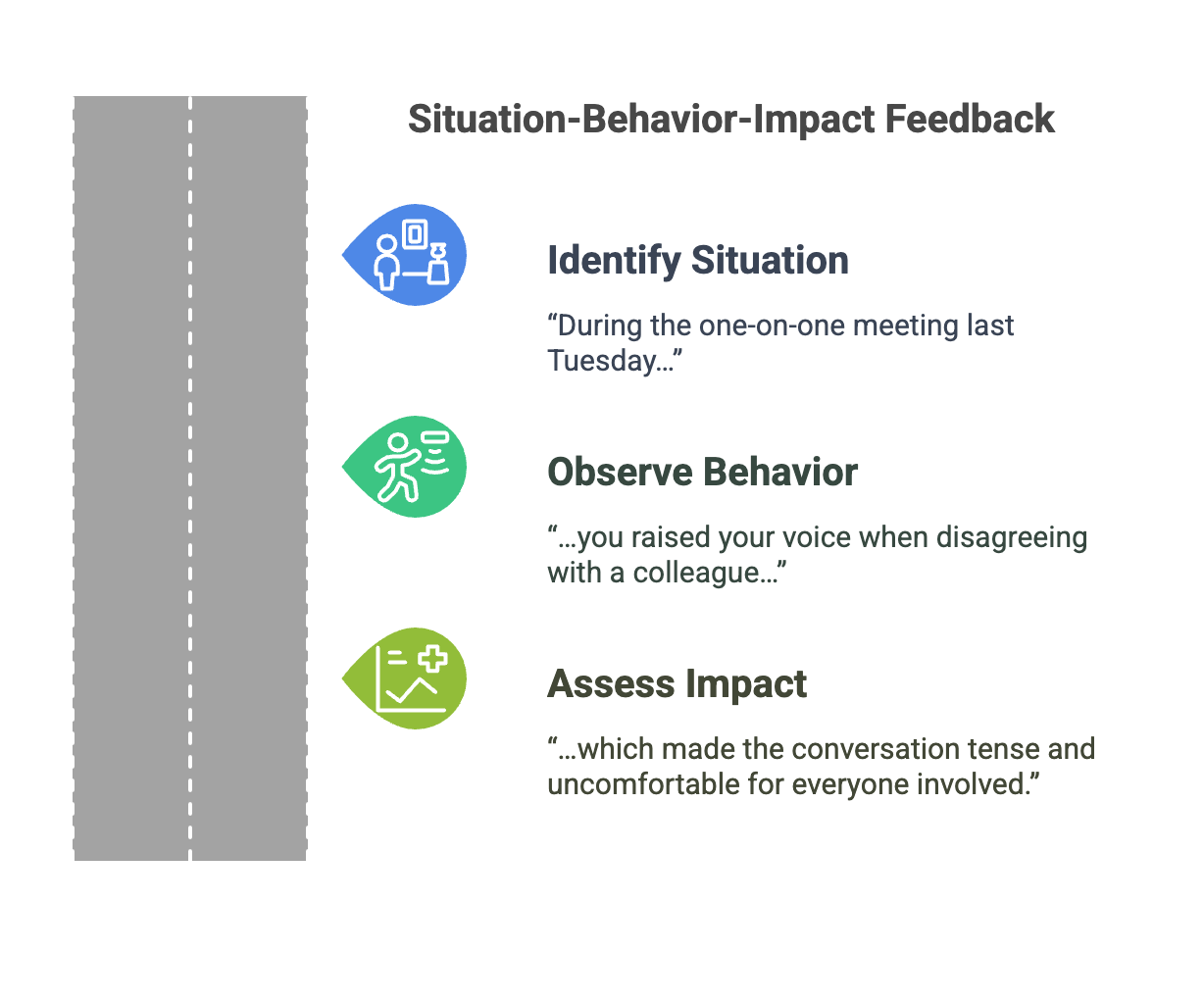
- Situation, behavior, impact: To give more precise and less arrogant feedback formulate your sentences by describing
- the situation you saw,
- the behavior (i.e., what the person did, either good or bad),
- the impact you observed.
- Unspoken criticism explodes: Staying silent too long about something that frustrates you at work, just like in your personal life, increases the risk of an eventual outburst that could damage relationships or make you seem irrational. To avoid this, speak up early—unless you're too angry in the moment, in which case, pause before responding.
- Listen-challenge-commit: Avoid rushing to demand change before allowing the person to challenge your perspective. The goal is to foster an open conversation where they feel heard and engaged—even if they disagree. If someone feels like their fate is already decided, they’ll have little motivation to improve.
My Take on Radical Candor
Kim Scott distilled decades of experience in team management and CEO coaching into clear, practical concepts. Radical Candor delivers a high wisdom-per-page ratio, though it’s not necessarily an easy read. If you’re not a people manager or don’t work in a large organization, the anecdotes from tech CEOs may feel distant. Additionally, the book’s focus on structured meetings and long feedback loops may be less relevant if your goal is to "get what you want by saying what you mean".
What are the main points of Radical Candor?
Radical Candor emphasizes the balance between Caring Personally and Challenging Directly to provide honest, constructive feedback. It promotes open communication, effective leadership, and fostering a culture where people feel supported while being pushed to improve.
How do you explain Radical Candor?
It’s a leadership and communication approach that encourages honest feedback with empathy, ensuring that difficult conversations lead to growth rather than resentment. It helps create an open, trust-based work environment where people can improve without fear of unnecessary harshness.
What are the 4 quadrants of Radical Candor?
The four quadrants are Radical Candor (caring personally while challenging directly), Ruinous Empathy (caring without challenging), Obnoxious Aggression (challenging without caring), and Manipulative Insincerity (neither caring nor challenging).
